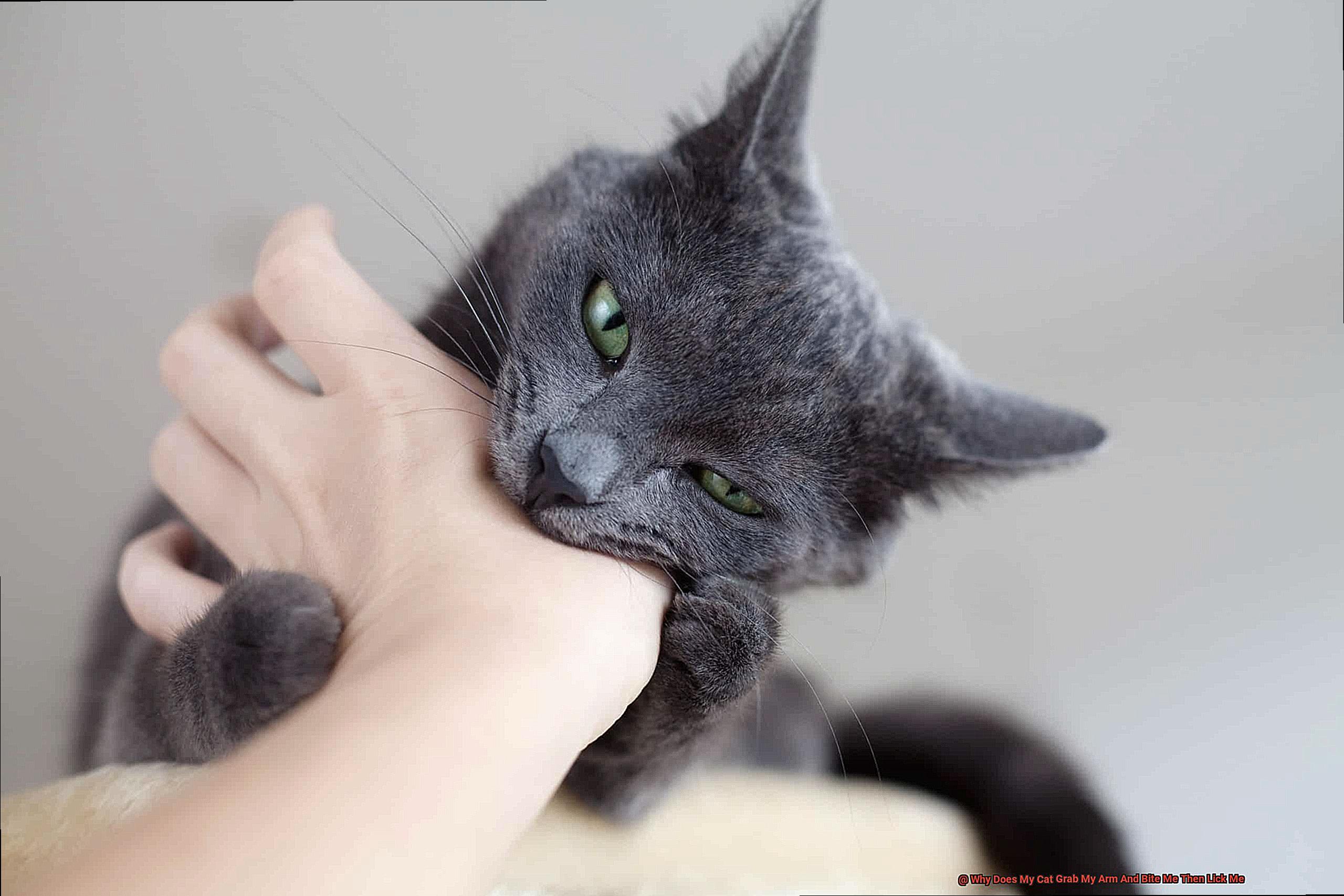Picture this: you’re playing with your adorable feline friend, and suddenly, out of nowhere, they bite you. But before you can even react, they start licking you. What’s up with that? If you’re a cat owner, chances are you’ve experienced this perplexing behavior at some point.
At first glance, it may seem like your cat is trying to hurt you. However, fear not. This is actually a common behavior among cats known as “love biting.” It’s their way of showing affection and trust in their own unique way.
In this blog post, we’ll explore the fascinating reasons behind why cats love bite and lick us. We’ll delve into the different theories behind these behaviors – from marking territory to seeking attention or even acting out due to stress. We’ll also provide some tips on how to manage love biting behavior so that you can enjoy your cat’s company without worrying about those sudden sharp teeth.
So whether you’re a seasoned cat owner or just starting out on your feline journey, let’s dive into the intriguing world of why cats grab our arms and bite us only to follow it up with an unexpected lick. Get ready for some pawsitively interesting insights.
What is the Purpose Behind This Behavior?
While this may seem like an odd and sometimes painful behavior, there is usually a purpose behind it.
One of the primary reasons your cat might exhibit this behavior is as a form of play. As natural hunters, cats thrive on activities that simulate the hunt. When they grab onto your arm and bite, they are mimicking the action of hunting prey. The subsequent licking is a way for them to show affection towards you and calm themselves down after the excitement of playtime.
Another reason for this behavior could be a sign of affection. Cats have scent glands on their face that they use to mark objects and people they consider important. When a cat bites and licks their owner, they are marking them with their scent as a way to show ownership and affection.
However, not all biting behavior from cats is playful or affectionate. Sometimes, cats may bite as a warning sign to communicate when they feel threatened or overwhelmed. In such cases, it’s crucial to understand your cat’s body language and behavior to determine the cause of the biting behavior.
To better understand your cat’s motives behind this type of behavior, it’s important to pay attention to their body language and behavior cues. By doing so, you can learn to interpret your cat’s signals and respond appropriately, whether it’s by providing more playtime or giving them space when needed.
Is it Playtime or Dominance?
While playful nips and bites are usually harmless, it’s important to understand your cat’s body language and context of behavior to differentiate between play and dominance.
Observing your cat’s body language is key in determining whether they’re playing or showing aggression. Pointed ears and a relaxed tail are good indicators of playfulness, while flat ears and a twitching or fluffed up tail suggest aggression or dominance. Additionally, consider the context of the behavior. If your cat only bites during playtime and doesn’t show any signs of aggression outside of these times, they’re likely just having fun. However, biting during grooming or feeding may indicate dominance.
The force of the bite is another factor to consider. Gentle bites are playful and shouldn’t cause any pain or injury, while hard bites may indicate aggression or dominance. It’s important to remember that cats are natural hunters and biting is a way for them to mimic the hunt. However, they also use biting as a way to show affection and calm down after playtime.
To sum it up, here are some key points to keep in mind when trying to determine if it’s playtime or dominance:
- Observe your cat’s body language: Pointed ears and a relaxed tail indicate playfulness, while flat ears and a twitching or fluffed up tail suggest aggression or dominance.
- Consider the context: If your cat only bites during playtime, they’re likely just having fun. However, biting during grooming or feeding may indicate dominance.
- Pay attention to the force of the bite: Gentle bites are playful, while hard bites may indicate aggression or dominance.
Could Overstimulation be an Issue?
This abrupt shift in behavior can be alarming and confusing for both you and your cat. It’s possible that this may be due to overstimulation.
Overstimulation is a common cause of cats lashing out at their owners. It happens when a cat becomes too excited or aroused during playtime or petting sessions. The energy builds up until the cat feels overwhelmed and releases it with a sudden bite. This behavior can be concerning, particularly if it becomes aggressive.
To prevent overstimulation, it’s essential to understand your cat’s personal boundaries for play and affection. By observing their body language, you can recognize the signs of overstimulation. Dilated pupils, twitching tail, flattened ears, and an agitated body posture are all indicators that your cat may be feeling overstimulated.
When these signs are present, the best course of action is to stop the interaction and give your cat some space to calm down. It’s also helpful to provide plenty of interactive toys and opportunities for playtime. This allows your cat to release their energy in a safe and appropriate manner.
In addition to preventing overstimulation, it’s crucial to note that this behavior may be a symptom of underlying behavioral issues or medical conditions. If the behavior persists or intensifies, consulting with a veterinarian or animal behaviorist is strongly recommended.
What Can You Do When Your Cat Bites and Licks You?
While it can be frustrating, it’s important to remember that cats have their own unique ways of communicating. So, what can you do when your cat bites and licks you?
Firstly, it’s essential to understand that cats use grooming as a way to bond with their owners. When a cat licks you, it’s a sign of affection, and they are trying to strengthen your relationship. However, biting can also be a sign of playfulness or excitement. To determine whether your cat is being affectionate or aggressive, pay attention to their body language and the context of the situation.
If your cat’s biting and licking behaviors seem more frequent or intense than usual, it could be a sign of boredom or anxiety. Cats need mental and physical stimulation to stay happy and healthy, so ensure they have plenty of toys and scratching posts to keep them occupied. If your cat is feeling stressed or anxious, try creating a calming environment by providing hiding spots and minimizing loud noises.
To discourage biting and scratching behavior, establish clear boundaries with your cat. Teaching them which behaviors are acceptable and rewarding positive behaviors like gentle grooming or cuddling can help. Consistency is key – if you don’t want your cat to bite you during playtime, then don’t encourage rough play.
Here are some additional tips that can help:
- Regularly trim your cat’s nails to reduce the damage caused by bites and scratches.
- Use positive reinforcement techniques such as treats or praise to reinforce good behavior.
- Consider using pheromone sprays or diffusers to calm your cat if they are experiencing anxiety or stress.
- Consult with a veterinarian or animal behaviorist for additional guidance on managing your cat’s behavior.
Learn to Interpret Your Cat’s Body Language
Cats have a complex and nuanced way of communicating through their body language, and understanding it is essential to building a strong bond with your feline friend. In this article, we’ll explore the different cues that cats use to express their emotions and intentions.

One common behavior that can be confusing for cat owners is when their pet grabs and bites their arm during playtime. However, this behavior is usually an indication of overstimulation rather than aggression. As natural predators, cats have an instinctive urge to hunt and play, and when they get excited, they may become overstimulated and nip at their owner’s arm. It’s a sign that they’re having fun and want to continue playing.
On the other hand, fear or anxiety can also cause cats to grab their owner’s arm and bite them. Cats are territorial animals, so if they feel threatened or insecure, they may become defensive and try to defend themselves by biting. This behavior is more common in rescue cats or those who have experienced trauma.
Believe it or not, some cats may grab their owner’s arm and bite as a form of affection. It may seem counterintuitive, but cats have a unique way of showing their love for their humans. Playful biting or nibbling can be a sign of intimacy and trust between cat and owner. This behavior is more typical in kittens but can continue into adulthood.
So how can you prevent your cat from grabbing your arm and biting you? Providing plenty of mental and physical stimulation through toys, scratching posts, and interactive playtime can help reduce overstimulation. Establishing clear boundaries during playtime by redirecting your cat’s attention to toys instead of your arm can also help. Finally, being patient with your cat and understanding their unique ways of communication is essential.
How to Respond Appropriately to Your Cat’s Bite and Lick
Although this behavior can be perplexing and even painful, it’s important to keep in mind that cats have their own way of communicating with us, and biting is just one of them.
When your cat bites you, it’s vital to remain calm and avoid any sudden movements that could startle your cat. If the bite breaks the skin, wash the wound thoroughly with soap and water and apply antiseptic cream to prevent infection. Identifying the reason behind the biting is also crucial. Did you accidentally startle them, or did they become overstimulated during playtime? Determining the trigger can help prevent future incidents.
If your cat bites you during playtime, redirect their attention to appropriate toys or scratching posts. This can help release their energy without resorting to biting. You can also try using toys that simulate hunting behaviors, such as feather wands or laser pointers. However, never punish your cat for biting as it can increase their stress levels and lead to more aggressive behavior.
On the other hand, when your cat licks you, it’s often a sign of affection. You can show affection in return by petting them or offering treats. But if their licking becomes excessive or uncomfortable, it may be necessary to set boundaries and redirect their behavior.
If you’re still struggling with your cat’s biting and licking behavior, don’t hesitate to seek professional help from a veterinarian or animal behaviorist. They can determine the underlying cause of the behavior and develop a plan to address it.
Tips to Help Avoid Unwanted Biting and Licking
There are several tips you can follow to prevent this behavior.
Firstly, providing plenty of playtime is crucial. Cats have a lot of energy that needs releasing, and interactive toys like feather wands or laser pointers can keep them entertained and engaged. This will reduce their desire to bite or lick you.
Secondly, using positive reinforcement is an effective training tool. Whenever your cat behaves well and refrains from biting or licking you, reward them with treats or praise. This will encourage them to continue behaving well and discourage negative behavior.
Thirdly, if your cat starts biting or licking you, try redirecting their attention to something else. Provide them with a toy or treat that they can focus on instead of you. This will distract them from their biting or licking behavior and encourage them to engage in more appropriate activities.
Fourthly, avoid rough play with your cat as it can actually encourage biting and scratching behavior. Instead, focus on gentle play that doesn’t involve excessive physical contact. This will prevent your cat from getting overly excited and engaging in unwanted biting or licking behavior.
Lastly, if your cat’s biting and licking behavior becomes severe or unmanageable, seeking help from a professional veterinarian or animal behaviorist may be necessary.
Conclusion
As a cat owner, you may have found yourself in the midst of your furry friend’s sudden biting and licking behavior. But don’t worry. This is actually a common behavior known as “love biting,” which is their way of showing affection and trust in their own unique way.
There are several reasons why cats exhibit this behavior, including playfulness, marking territory, seeking attention, or even acting out due to stress. It’s important to understand your cat’s body language and behavior cues to determine the cause of the biting behavior.
To decipher whether your cat is playing or showing aggression, it’s crucial to observe their body language. Pointed ears and a relaxed tail are good indicators of playfulness, while flat ears and a twitching or fluffed up tail suggest aggression or dominance.
It’s also essential to respect your cat’s personal boundaries for play and affection. By recognizing signs of overstimulation through their body language, you can give them space when needed.
Providing plenty of mental and physical stimulation through toys, scratching posts, and interactive playtime can help reduce overstimulation. Establishing clear boundaries during playtime by redirecting your cat’s attention to toys instead of your arm can also be beneficial.
Remember that cats have their own unique ways of communicating with us. Being patient with them and understanding their behaviors is crucial for building a strong bond with our feline friends.







